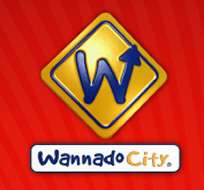Wannado City
|
The Wannado City "sign" logo. | |
| Slogan | Where kids can do what they wanna' do. |
|---|---|
| Location | Sunrise, Florida, U.S. |
| Owner | Grupo CIE |
| Opened | 2004 |
| Closed | 2011 |
| Operating season | Year-round |
| Area | 140,000 square ft |
| Website | www.wannadocity.com at the Wayback Machine (archived December 23, 2010) |
Wannado City was an indoor role-playing amusement center at the Sawgrass Mills Mall in Sunrise, Florida, a suburb of Fort Lauderdale. It was a property of Grupo CIE. Billed as "where kids can do what they wanna do," it was a child-sized representation of a metropolis where children aged 2–14 could participate in different careers and other lifelike activities. The concept of the theme park was taken from the KidZania concept, which was brought by Luis Javier Laresgoti five years after the KidZania concept was taken in 1996. However, Kidzania and Wannado City lost ownership interests in 2004, and when Wannado City opened, both parties went separate ways.
Careers in which the "kidizens" could participate included firefighter, police officer, lawyer, TV reporter, and singer. They could also use issued money, "Wongas", to set up bank accounts.
Due to financial problems, alongside lack of business, Wannado City closed in 2011. It is now occupied by a new wing of stores called " Fashion Row". [1]
Overview
Money System
The system was functioned by the idea of participation in different activities, gain capital and spend their earnings in luxurious visits such as the Wonka Factory, The Coca-Cola Bottling Plant, a Publix supermarket, the Wannado City Fair and a permanent circus. Guests were granted 150 Wongas upon their arrival, and were awarded 20 Wongas for each activity. There were also ATMs where guests could withdraw money or make a deposit at a State Farm bank, so that guests would not have to carry their money around. Children were given "ATM cards" so that they are able to deposit and withdraw more efficiently. The "ATM cards" were discontinued in 2006.
Careers
The city hosted numerous job occupations available for selection. Children could star in their own television newscast, join the city's fire or police department, the Miami Herald and the Spirit Airlines Flight Academy. The city also hosted a theater, circus, hospital, movie studio, recording studio, courthouse, bakery, dentistry office, public park, library, mine, and an archaeological/paleontological site, among other locations.[2]
Security
Upon arrival, the children and parents were given RFID security bracelets. Throughout the park there were computer stands where a person would place their bracelet against a scanner and details of any known individual's location were shown.
